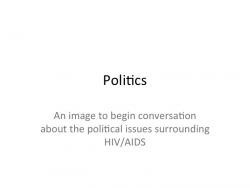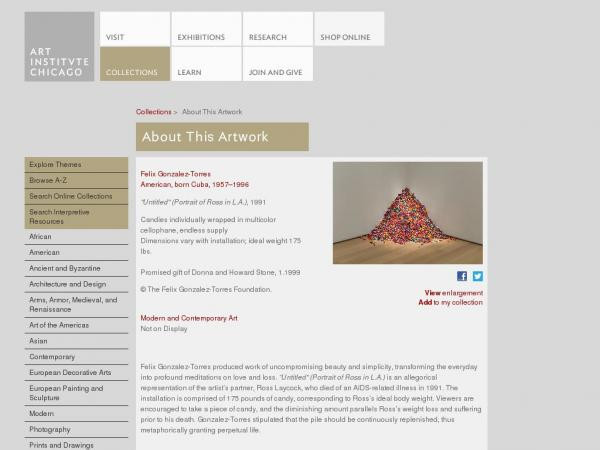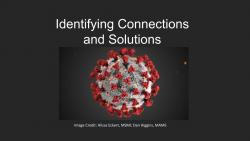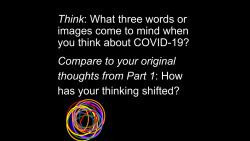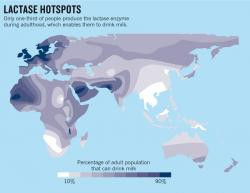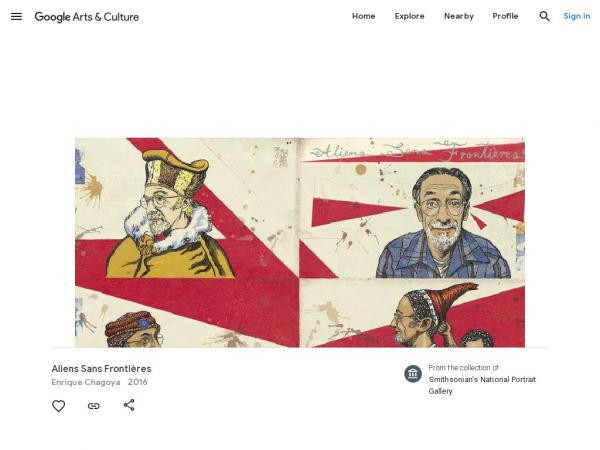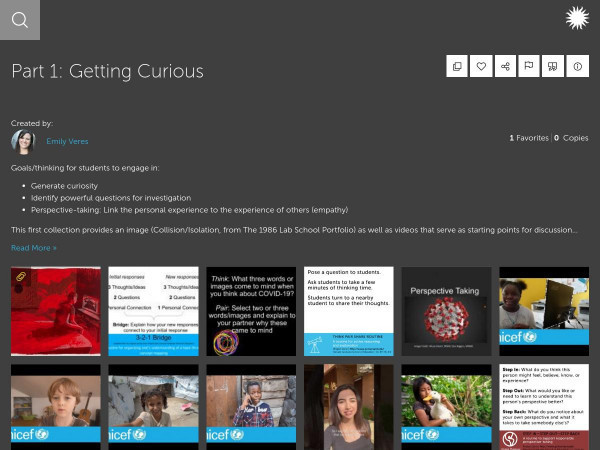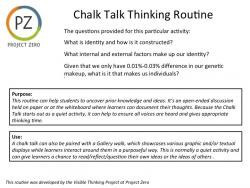Emily Veres's collections
Vaccination artifacts
<p>Projected the images without identifying information in order to stimulate thinking and questions.</p>
 Emily Veres
Emily Veres
5
The Global Implications of HIV/AIDS - An Interdisciplinary Exploration
<p>This collection includes several images that could be used as starting points for students to engage in a dialogue about the complexities of HIV/AIDS. I would very much encourage students to be given choice when exploring a topic from an interdisciplinary approach, but often it can be helpful to provide a starting point. Works of art can be used, as there are opportunities for students to engage in conversations in pairs or small/large groups about multifaceted issues such as this. A painting or photograph can provide a low-risk way of beginning a discussion about challenging topics. </p>
<p>Students should feel free to use other areas of knowledge beyond what I have included such as Geography and History or more detailed topics such as stigma or virology. Data from the local Department of Health could also be used in addition to or in place of the Gapminder HIV Chart. To see a sample exploration that could be used in place of a much larger interdisciplinary exploration, please see the collection titled "The Global Implications of HIV/AIDS."</p>
 Emily Veres
Emily Veres
18
The Global Implications of HIV/AIDS
<p>This activity can be used on its own or as a starting point for an interdisciplinary exploration of the global implications of HIV/AIDS.</p>
<p>This collection includes a three-part activity that can be modified by choosing to spend more or less time considering other viewpoints on HIV/AIDS. It uses Project Zero Thinking Routines and several images that allow students to explore multiple perspectives on HIV/AIDS. I have also created a separate collection with more images that could be used as starting points for further conversation called “The Global Implications of HIV/AIDS - An Interdisciplinary Exploration.” </p>
<p>The focus of this particular collection is to allow students to begin exploring at the individual level and then keep zooming out to the global level to engage with HIV/AIDS as a global issue.</p>
<p>Part I: The individual and Individuals within a Society
</p>
<p>Using a work by Felix Gonzalez-Torres and the Project Zero Thinking Routine “See, Think, Wonder,” students can begin the conversation about the toll of HIV/AIDS on the individual level. Depending on student comments, this could also involve individuals within a society. The video included here could be shown as a follow-up explanation or could simply be used to help the teacher and not shown to students. The images of the quilt panel and the poster could both be used with the Project Zero Thinking Routine “Circle of Viewpoints” to help further the society or systems approach. These images allow students to explore the political complexities and how this can directly impact individuals within a group. Again, the video included could be used to enhance teacher and/or student knowledge.
</p>
<p> </p>
<p>Part II: Engaging in conversations about Society and Global Issues
</p>
<p>Students will use the Project Zero Thinking Routine “See, Think, Wonder” to explore the Gapminder HIV Chart graphic (axes have been removed). If the group of students you are working with have less experience with thinking routines in general or are less inclined to take risks in sharing out, skip to the original version of the Gapminder HIV Chart graphic instead. At either starting point, more information can be revealed as students pose thoughts and wonders about the data provided. The link to the TedTalk can help students better understand what the graph is showing and perhaps be another starting point for a dialogue on the complexities of HIV/AIDS. </p>
<p>
</p>
<p>Part III: Reflection
</p>
<p>There is some reflection built into the “Circle of Viewpoints” Thinking Routine but it is worthwhile to also reflect at the end of the activity. I have provided the Project Zero “I used to think…But now I think” Thinking Routine slide but a teacher could also choose to return to the Wrap Up questions provided from the earlier “Circle of Viewpoints” Thinking Routine and revisit what the students had mentioned from Part II.
</p>
<p></p>
 Emily Veres
Emily Veres
13
Part 2: Inquiring
<p>Goals/thinking we want the students to engage in:</p>
<ul><li>Inquiry: focusing one or more questions asked from exploration in the first collection</li><li>Research: an opportunity to explore expert sources to consider one or more perspectives</li><li>Mapping: Construct a map to consider the global implications of COVID-19</li></ul>
<p></p>
<p>Description: In this collection, students have the opportunity to research about SARS-CoV-2 (COVID-19) and consider the many perspectives of this global pandemic. </p>
<p></p>
<ol><li>Focusing the Question: It is important to provide time for students to consider the nature of their question and ensure that they have asked a focused but open-ended question. <ol><li>Each student should already have some questions from Part 1 (Getting Curious) and may have new questions to add to their list. These questions can be grouped by theme or shared area/theme of interest. </li><li>The Project Zero Thinking Routine ‘Generate - Sort - Connect - Elaborate’ can be used to scaffold thinking or help students understand the connections between questions. The thinking routine could be adapted to consider generating questions in place of ideas as well as the criteria by which students are asked to sort.</li><li>For each group of questions, students should consider why those questions matter using the Project Zero Thinking Routine ‘The 3 Y’s’. This can help students identify why certain questions have both local and global contexts and should allow for questions to be rewritten or re-focused. </li><li>This scaffolded process should allow students to identify one question and why asking that question matters. </li></ol></li><li>Perspectives and Relevant Thinking<ol><li>After selecting a question, students should consider whose perspective is needed to address the question. Which expert(s) could be consulted in order to attempt to answer this question? Students may find that multiple experts' perspectives are relevant and it’s often the case that lateral thinking is needed when considering global questions. </li><li>This collection includes several relevant museum images of objects as well as links to resources students can use to consider various perspectives and gather relevant information. Students can use any research included here as well carry out their own research.</li><li>Main Takeaways: After researching their chosen question, students should narrow down the information to three main takeaways. These can be shared with the class in written or video format to help students identify connections between questions. Videos could be made and shared among a group of students using <a href="https://info.flipgrid.com/">Flipgrid</a> or any platform such as Google folders. (Flipgrid is free; students can create a video with a length set by the teacher and other students can view and comment on the videos of their classmates)</li><li>Students may end up having shared questions or areas of interest and could work in pairs or small groups of 3-4. Each group could produce one video together or each member could share their own personal take-aways. </li><li>Each student should watch 2-3 videos from other groups and comment, making connections. </li></ol></li><li>Putting it all together - a collaborative map<ol><li>The implications of Covid-19 are far-reaching. How can we best represent the complex interactions? There are many ways, and with my own classes I chose for them to plan and create a collaborative mind map. Each area of interest had space on the map and students shared information they learned through inquiry and research by documenting their main takeaways as well as drawings, statistics, etc.</li><li>Students were given the opportunity to build connections from watching the videos and reading the information on the map and draw physical lines between related perspectives. These lines show the interconnected nature of such a complex global problem. </li><li>In a virtual learning situation online mapping tools, such as Coggle, could be used in place a large paper version</li></ol></li></ol>
<p></p>
<p>I have provided samples of past student work within the collection for previous explorations of Ebola and Zika as well as this year’s exploration of COVID-19. The collaborative map is very large (about 2 meters by 2 meters) as I had taped two long pieces of butcher paper together. Even though each group of students created their own video to share their research, the mind map was collaborative, with one map being organized and created by the students. </p>
<p></p>
 Emily Veres
Emily Veres
39
Part 1: Getting Curious
<p>Goals/thinking for students to engage in:<br></p>
<ul><li>Generate curiosity</li><li>Identify powerful questions for investigation</li><li>Perspective-taking: Link the personal experience to the experience of others (empathy)</li></ul>
<p>This first collection provides an image (Collision/Isolation, from The 1986 Lab School Portfolio) as well as videos that serve as starting points for discussion. Students can use the adapted version of the 3-2-1 Bridge Project Zero Thinking Routine to explore their connection to the image and document their thinking. The thinking routine also provides the first opportunity for students to pose questions. At the end of this first collection, students will take a second look at this same image.</p>
<p>Before watching the videos, ask students to write down three words or images that come to mind as they think about COVID-19 as well as why they chose those particular words or images. Using the Think, Pair, Share Project Zero thinking routine, choose 1-2 words or images and explain to your partner why you chose them. Pairs can share out to the larger group or add to a digital collection of responses. Students will revisit these during a reflection activity in the fourth collection. </p>
<p>As a step towards perspective-taking and developing empathy, students could select a few of the video diaries from around the world to watch. “UNICEF asked children from around the world to document their lives at home to get a glimpse into their world and to inspire others.” These video diaries offer a human-centered approach and help us to consider what else we need to know about others in order to fully explore the implications of COVID-19. The Project Zero Thinking Routine ‘Step In - Step Out - Step Back’ could be used to help “learners to identify individuals with various perspectives in a given situation; provide evidence for thoughts, values and feelings these individuals may hold; and explain how societal or more macro-forces—particularly roles and relationships—shape their perspectives.” </p>
<p>Once they have had an opportunity to share their perspectives, students should watch the video “Are Ice Cream Trucks Essential? In N.Y.C., They Are.’ from The New York Times and consider which perspectives/variables are brought up (economic, etc). This could also be another opportunity for students to pose inquiry questions of their own. Depending on time, teachers could use the Main, Side, Hidden Project Zero thinking routine to further scaffold student thinking. </p>
<p>Using the same starting image (Collision/Isolation, from The 1986 Lab School Portfolio), students should document their thinking after a second look. After re-reading their first thoughts, add the new instruction to consider the "bridge" part of the routine, which shows the transition from prior knowledge to new understandings that have been built so far.</p>
<p>The next collection in this series (Part 2: Inquiring) provides resources to support inquiry and research in order to facilitate the making of a collaborative map.</p>
<p></p>
 Emily Veres
Emily Veres
18
Lactase Persistence and Human Migration
<p>How can genetics help us to understand human migration? In this collection, students will use maps, articles, and videos to analyze genetics research about lactase persistence before building their own maps to understand the co-evolution of genes and culture. </p>
<p>This collection can be used in a Biology classroom with units on enzymes, genetics and/or human evolution, in an interdisciplinary unit to link Math with Biology (students to use ratios, statistics, and data to build a map) or in a Geography course.</p>
<p>Students should be either given a color copy of the lactase persistence map or it could be projected. Once students have been given the time and opportunity to look at the map, the following questions should be asked.</p>
<ol><li>What do you notice about this map?
</li><li>What questions do you have about this map?
</li><li>What can this map show us about human migration?</li></ol><p>Next, ask students to work in groups, each choose one of the following three articles to read, then share a brief summary of their article with those in their group. These articles are excellent resources that provide different perspectives on lactase persistence and evolution. The first article (the source of the lactase persistence map) provides a clear explanation of what we can learn from milk fats found on ancient pottery shards and the link between lactase persistence and migration. The second article focuses on animal domestication and the third on the nutritional benefits of being able to digest lactase as a selective advantage.</p>
<p>The third article also connects lactase persistence, the shift to agricultural communities, and human migration with the genetics of human skin color. This could provide an opportunity for students to discuss the inheritance of skin color and perhaps skin color and race. A separate collection has been made to help discuss this and can be found <a href="http://learninglab.si.edu/q/ll-c/6DLemmMqyxoy6s11">here</a>.
</p>
<p>In the activity section, the Howard Hughes Medical Institute BioInteractive (HHMI) video summarizes some key aspects about the genetics of lactase persistence as well as some of the history. If students have already read and shared out to show understanding, the video could be used to meet the needs of students who tend to be more auditory learners. The activity “Patterns in the Distribution of Lactase Persistence,” also from HHMI, guides students though an understanding of the co-evolution of genes and culture. “Students analyze data obtained from published lactase-persistence studies involving many populations sampled around the world. The activity involves calculating percentages, drawing pie charts, plotting the pie charts on a world map, and analyzing the data. This lesson provides an interdisciplinary approach to studying lactase persistence, connecting biological concepts and data analysis to world geography and culture”. (<a href="https://www.biointeractive.org/sites/default/files/Patterns-in-the-Distribution-of-Lactase-Persistence-Educator.pdf">https://www.biointeractive.org/sites/default/files/Patterns-in-the-Distribution-of-Lactase-Persistence-Educator.pdf</a>)</p>
<p>The map the students create can be compared to the initial image provided (a map of lactase persistence) as well as the information provided by the Smithsonian Magazine articles to predict the path of human migration. Based on the initial map, reading and activity, students can show their understanding of the connection between genetics and human migration by using the Project Zero thinking routine ‘Claim, Support, Question’. Claims can be made based on their new knowledge and then supported with evidence from the map, reading or activity. Then, students can pose questions for further research or discussion.</p>
<p>In the additional resource section, a YouTube clip has been provided to further extend the conversation. Sarah Tishkoff, from the earlier HHMI video, does an excellent job explaining the co-evolution of culture and the gene for lactase persistence.
</p><p></p>
 Emily Veres
Emily Veres
10
Exploring Identity: How can portraiture conceal or reveal?
<p>What is identity? How is it constructed? These activities investigate how portraits can conceal or reveal aspects of identity. How does the artist choose to portray an individual? How does the sitter choose to be shown?</p>
<p>This collection includes a three-part activity that can be modified by choosing to spend more or less time sharing out as a group. It begins with a discussion about identity, using the Chalk Talk Thinking Routine and a comparison of two portraits to further push students' thinking on how portraiture can both conceal and reveal aspects of identity. In the next parts of the activity, students are able to choose from a variety of portraits for individual reflection and then come together as a group to discuss a larger work to about culture and identity. Several Project Zero Thinking Routines can be used to stimulate and record thinking. </p>
<p><strong><br /></strong></p>
<p><strong>Part I: Chalk Talk and comparing portraits</strong></p>
<p>Students participate in the Chalk Talk Thinking Routine using the questions provided. A quick gallery walk where students circulate and read all responses can allow the class to get a feel for the many (or singular) perspective(s) of identity. Using the See-Think-Wonder Thinking Routine, students compare and contrast two portraits: LL Cool J by Kehinde Wiley and John D. Rockefeller by John Singer Sargent. Students can share with a neighbor and then out to the larger group or simply share out as a large group depending on class size, etc. </p>
<p>
</p>
<p><strong>Part II: Portraiture and Identity</strong>
</p>
<p>Using the Individual Exploration of Portraiture worksheet, students can choose one image from the fifteen provided and spend some time exploring their selected portrait. Students can be given 5-10 minutes to interact with their chosen image. Using one of Roger Shimomura’s portraits, students will use the Unveiling Stories Thinking Routine to better understand the many layers to this work of art. Again, students can share out in pairs first or simply share out to the whole group depending on class size, etc.</p>
<p>
</p>
<p><strong>Part III: Returning to chosen portrait and final reflection</strong>
</p>
<p>Students will once again return to their selected portrait and complete the "second look" section of the Individual Exploration of Portraiture worksheet. A final reflection about identity and portraiture can be completed either as a group or individually using the I Used to think…; But Now I Think… Thinking Routine.
</p>
<p>#NPGteach</p>
 Emily Veres
Emily Veres
23
Climate Change and Migration
<p>What will the future reveal about our choices and attitudes toward the natural world? This collection uses the painting 'Mamakadendagwad' by Tom Uttech and two Project Zero routines, ‘Ten Times Two’ and ‘Unveiling Stories,’ to start or continue a dialogue about the impact of humans on the environment.
</p>
<p>“Tom Uttech's visionary paintings emerge from a deep sense of communion with nature. As an accomplished birdwatcher, conservationist, wildlife photographer, and hiker, Uttech (born 1942) has spent his life engaging with the unspoiled wilderness of his native Wisconsin and the neighboring woodlands of northern Minnesota and Quetico Provincial Park in Ontario, Canada. Yet while Uttech's experience of the landscape is grounded in firsthand knowledge and close observation, his paintings do not represent specific scenes. Instead, he uses his understanding of the ecosystem's animals, plant life, light, and atmospheres to conjure fantastic reconstructions of the natural world.”. (<a href="https://americanart.si.edu/artwork/mamakadendagwad-110761">https://americanart.si.edu/artwork/mamakadendagwad-110761</a>) </p>
<p>Climate change is expected to cause larger migrations both within and across borders - displacing individuals from their homes. This movement is the result of many complex factors such as: sea level rise, desertification, extreme weather events, etc. While humans are certainly impacted by climate change, so are other living organisms. </p>
<p>This collection can be used in several classroom settings: Biology (ecology unit or any units that address human impact on the environment or relationships between living organisms), IBDP Environmental Systems and Societies (many connections with content throughout the course), AP Environmental Science (many connections with content throughout the course), Theory of Knowledge (when exploring the Natural Sciences Area of Knowledge or exploring knowledge claims about evidence), or Geography. </p>
<p>This collection could be used at the start, middle or end of a unit as there are valuable connections possible at any point; however, I think this would be a fantastic starting image for a unit. In the absence of any context of what is being learned in class, students may come up with a larger variety of observations and perhaps a more emotional connection with the painting.</p>
<p>Annotations attached to the painting provide information on how to guide student exploration with each of the thinking routines. </p>
<p>Extension: The first additional resource is a map showing the average direction mammals, birds, and amphibians need to move to track hospitable climates as they shift across the landscape. The following three articles are related to the moving map and should be used along with the map. Teachers could start with this moving map before showing the painting depending on their students’ level of interest and knowledge. Another extension could be analyzing data to draw conclusions about how migration changes biodiversity in various ecosystems. The last article from National Geographic explains that “…as the planet warms, species are shifting where, when, and how they thrive. They are moving up slopes and toward the poles. That is already altering what people can eat; sparking new disease risks; upending key industries; and changing how entire cultures use the land and sea”. (<a href="https://news.nationalgeographic.com/2017/04/climate-change-species-migration-disease/">https://news.nationalgeographic.com/2017/04/climate-change-species-migration-disease/</a>) Each of these articles highlight an aspect of the complexity of climate change and its impacts on the environment.
</p>
<p></p>
 Emily Veres
Emily Veres
10
Climate Change and Human Impact on the Environment
<p>What will the future reveal about the choices we are making and our attitudes toward the natural world? How might future generations judge these choices and attitudes? This collection uses the painting ‘Manifest Destiny’ by Alexis Rockman and two Project Zero routines, ‘See/Think/Wonder’ and ‘Unveiling Stories,’ to start or continue a dialogue about the impact of humans on the environment.
</p>
<p>“Alexis Rockman is a contemporary American painter known for his fantastical paintings of dystopian natural environments”. (<a href="http://www.artnet.com/artists/alexis-rockman/">http://www.artnet.com/artists/alexis-rockman/</a>) He depicts the future where creatures struggle to survive toxic conditions and invasive species. In Rockman’s paintings we see an absence of human beings, only the altered landscapes they have left behind. (<a href="https://www.artworksforchange.org/portfolio/alexis-rockman/">https://www.artworksforchange.org/portfolio/alexis-rockman/</a>)
</p>
<p>Climate change is expected to cause larger migrations both within and across borders - displacing individuals from their homes. This movement is the result of many complex factors such as: sea level rise, desertification, extreme weather events, etc. There is a direct impact on availability of resources such as food and clean water as well as a crisis of public health.
</p>
<p>This collection can be used in several classroom settings: Biology (ecology unit or any units that address human impact on the environment), IBDP Environmental Systems and Societies (many connections with content throughout the course), AP Environmental Science (many connections with content throughout the course), Theory of Knowledge (when exploring the Natural Sciences Area of Knowledge or exploring knowledge claims about evidence), or Geography. </p>
<p>This collection could be used at the start, middle or end of a unit as there are valuable connections possible at any point. An interesting interdisciplinary exploration that I have seen in the middle school Science setting is for students to visit local waterways affected by human impacts and take samples back to their lab to test for pH, phosphorus, etc. Then, students read about the importance of water ways in the spread of humans in their humanities or language class before writing poetry about the human impact on the environment in their second language class (half of the students took French while the other half took Spanish).
</p>
<p>Manifest Destiny could be integrated at any point during the interdisciplinary unit. For example, in the beginning to encourage questions or determine previous knowledge, the middle to spark curiosity, or at the end after students have more information about human impacts on the environment. </p>
<p>In addition to or in place of visiting a local waterway, a link to an interactive map can be found in the additional resources section of this collection. Students can research what communities will be impacted by rising water levels. A scale bar allows users to shift the water levels and observe changes to the area. A possible extension could be to consider how vulnerable communities tend to be the most impacted by water level rise. Two articles included within the additional resource collection provide perspectives from the United States and Australia. </p>
<p>Annotations attached to the painting provide information on how to guide student exploration with each of the thinking routines. Annotations attached to each website include possible questions to consider when using each additional resource.
</p>
<p></p>
 Emily Veres
Emily Veres
9

